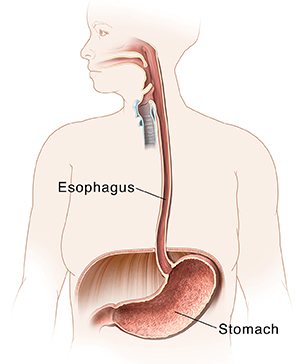Understanding Dysphagia
Understanding Dysphagia

If you have a problem swallowing foods or liquids, you may have dysphagia. This health problem has a number of causes. Your healthcare provider can find out what is causing your problem. Treatment can help ease your symptoms.
When you swallow
Your tongue pushes foods or liquids from your mouth to your throat as you eat or drink and swallow. They then pass down the esophagus (a muscular tube) into the stomach. The esophagus muscles tighten and relax in wavelike motions. This keeps foods or liquids moving.
Causes of dysphagia
With dysphagia, foods or liquids do not easily pass down the esophagus. Dysphagia may happen if the esophagus walls thicken. This can cause a narrowing (stricture) of the tube. Dysphagia can also be caused by:
-
A problem in the esophagus. This may be an ulcer, stricture, irritation, infection, inflammation, or cancer.
-
A problem with the muscles in your mouth, throat, or esophagus. They don’t work right or are not coordinated.
-
A nerve or brain problem, such as from a stroke, cerebral palsy, or Parkinson disease. It can leave your mouth, tongue, or throat muscles weak. Or it may change how your muscles work.
Common symptoms
If you have dysphagia, you may:
-
Feel chest pressure or pain when you swallow
-
Choke or cough when swallowing
-
Vomit after eating or drinking
-
Regurgitate food or liquid out your nose
-
Aspirate (breath into the lungs) foods or liquids when you swallow
-
Have fatigue and weight loss
Updated:
June 10, 2019
Reviewed By:
Jen Lehrer MD,Kenny Turley PA-C,L Renee Watson MSN RN